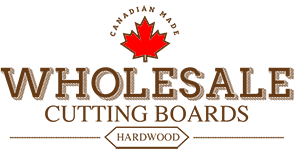Blog
What’s the Best Wood for Cutting Boards in Canada?
Choosing the right wood for your cutting board makes all the difference in durability, knife care, and food safety. In Canada, hard maple stands out as the top choice—and for good reason.
Here’s why maple is the best wood for cutting boards, along with key alternatives and maintenance tips to keep your board in top shape.
In this blog post, we’ll look at:
- Why maple is the best wood for cutting boards in Canada
- How maple stacks up against other hardwoods such as walnut and cherry
- Important things to look at when choosing a cutting board
- Tips on caring for your cutting board to keep it in great shape
Why Maple Is the Best Wood for Cutting Boards in Canada
Maple is the easiest to use material for wood cutting boards, and that’s understandable. It has the best balance of durability and knife-friendliness with a Janka rating of 1,450 lbf. Here’s why maple is better:
1. Ideal Hardness for Cutting Boards
- Hard enough not to fall prey to deep cuts and scratches
- Soft enough not to dull the knives excessively
- More dense than less dense softwoods such as pine, thus more durable
2. Naturally Antibacterial Properties
- Tight, small pores in Maple keep out bacteria and moisture
- Less likely to trap harmful microbes than open-grained woods
3. Widely Available in Canada
- Maple is a locally grown Canadian hardwood, thus more affordable and sustainable
- Often available in the area, with little environmental impact
4. Pleasing Aesthetic
- Light, creamy color that works with any kitchen decor
- May be left to build up a rich patina with proper care over time
Other Great Woods for Cutting Boards
While maple is the all-around champion, there are some other hardwoods that also excel as cutting boards. Here’s the lowdown:
1. Walnut (Janka: 1,010 lbf)
Pros: Dense dark brown color, softer than maple (less abrasive to knives)
Cons: More expensive, more absorbent than maple
2. Cherry (Janka: 950 lbf)
Pros: Rich reddish color, antimicrobial because of natural oils
Cons: Softer than maple, can exhibit knife marks more easily
3. Teak (Janka: 1,070 lbf)
Pros: Water-resistant due to natural oils, extremely durable
Cons: More expensive, may have strong initial odor
4. Bamboo (Janka: 1,300-1,400 lbf)
Pros: Tougher than some hardwoods, earth-friendly
Cons: Dulls knives faster, glued (may contain formaldehyde)
These are decent options, but maple is still the all-around best option for most Canadian kitchens.
What to Avoid in a Wooden Cutting Board
Not all timbers are created equal when it comes to cutting boards. Avoid these varieties:
1. Softwoods like Pine, Cedar, Spruce
- Too soft, making deep grooves for bacteria to thrive
- Prone to splitting and warping
2. Open-Grained Woods (Oak, Ash)
- Large pores trap food particles and bacteria
- Not suitable for food safety
3. Toxic Woods (Pressure-Treated, Exotic Species with Irritants)
- Certain woods (rosewood, yew) contain natural poisons
- Use only food-grade hardwoods
How to Care for Your Maple Cutting Board
To derive the maximum life from your maple cutting board:
1. Regular Cleaning
- Wash in mild soap and warm water (very important: do not soak)
- Sanitize with a mixture of vinegar and water (1:1)
2. Oil Monthly
- Use food-grade mineral oil or beeswax to prevent drying and cracking
- Apply generously, let soak, then wipe off excess
3. Avoid Warping & Cracking
- Never put in the dishwasher
- Store upright or in a dry place
- Rotate sides to ensure even wear
Final Verdict: Maple Is the Best Wood for Cutting Boards in Canada
For most Canadian households, maple is the best wood for cutting boards due to its best hardness, antibacterial nature, and affordability. While walnut and cherry are good replacements, maple’s durability and knife friendliness secure it as the top option.
Key Takeaways:
- ✅ Top Pick: Maple (1,450 lbf Janka) – friendly to knives, antibacterial, durable
- ✅ Alternatives: Walnut (elegance, softer) & Cherry (beauty, antimicrobial)
- ❌ Steer Clear: Softwoods, open-grained woods, toxic species
- 🔧 Maintenance: Clean gently, oil monthly, avoid soaking
By picking a high-quality maple cutting board and maintaining it properly, you will have a long-lasting, hygienic kitchen essential.
